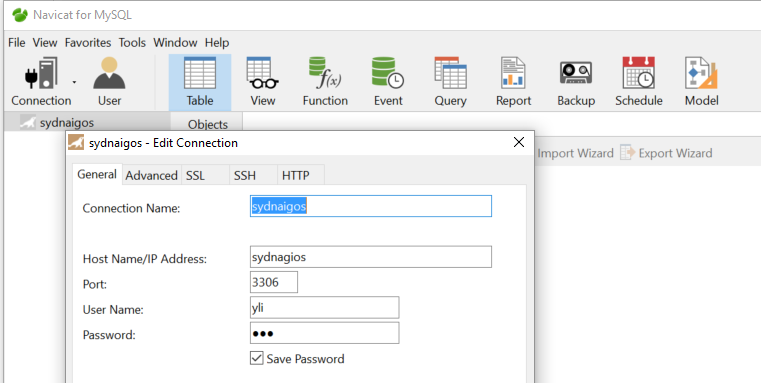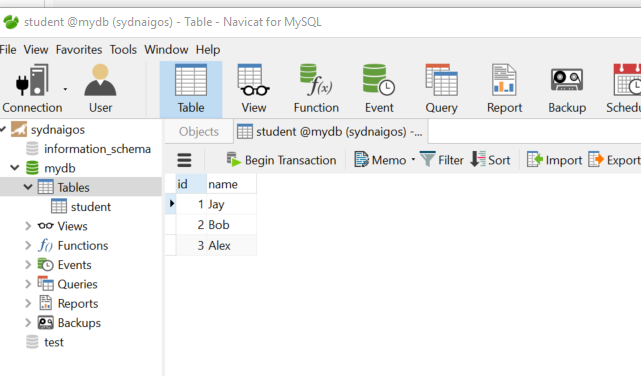Python 学习笔记 - 操作MySQL
Python里面操作MySQL可以通过两个方式:
-
pymysql模块
-
ORM框架的SQLAchemey
本节先学习第一种方式。
学习Python模块之前,首先看看MySQL的基本安装和使用,具体语法可以参考豆子之前的博客http://beanxyz.blog.51cto.com/5570417/1609972
或者官方简介
https://mariadb.com/kb/en/mariadb/basic-sql-statements/
简单的回顾一下基本环境的搭建:
首先安装Mariadb(我的环境是CentOS7)
|
1
2
|
yum install mariadb*systemctl start mariadb |
配置防火墙
|
1
2
|
firewall-cmd --add-port=3306/tcp --permanentsystemctl restart firewalld |
配置root密码
|
1
2
|
mysqladmin -u root password 'mysql'mysql -uroot -p |
创建一个测试用的数据库和表
|
1
2
3
4
5
6
7
8
9
10
11
12
13
14
15
16
17
18
19
20
21
|
MariaDB [(none)]> create database mydb;Query OK, 1 row affected (0.00 sec)MariaDB [(none)]> use mydbDatabase changedMariaDB [mydb]> create table student(id int not null auto_increment,name varchar(10), primary key(id));Query OK, 0 rows affected (0.04 sec)MariaDB [mydb]> insert into student(name) values('Jay'),('Bob'),('Alex');Query OK, 3 rows affected (0.00 sec)Records: 3 Duplicates: 0 Warnings: 0MariaDB [mydb]> select * from student;+----+------+| id | name |+----+------+| 1 | Jay || 2 | Bob || 3 | Alex |+----+------+3 rows in set (0.00 sec) |
创建一个远程访问的账户
|
1
2
3
4
5
6
|
MariaDB [(none)]> create user yli@10.2.100.60;Query OK, 0 rows affected (0.00 sec)MariaDB [(none)]> set password for yli@'10.2.100.60'=password('yli');Query OK, 0 rows affected (0.01 sec)MariaDB [(none)]> grant all privileges on mydb.* to yli@10.2.100.60;Query OK, 0 rows affected (0.00 sec) |
然后安装一个图形界面的工具Navicat,绑定数据库
这样一个基本的测试环境就搭建好了。
现在来看看pymysql的使用。
在我的客户端安装一下pymysql的模块
|
1
2
3
4
5
6
|
C:\WINDOWS\system32>pip install pymysqlCollecting pymysql Downloading PyMySQL-0.7.9-py3-none-any.whl (78kB) 100% |################################| 81kB 610kB/sInstalling collected packages: pymysqlSuccessfully installed pymysql-0.7.9 |
Python源码演示
查询
|
1
2
3
4
5
6
7
8
9
10
11
12
13
14
15
16
17
18
19
20
21
22
23
24
25
26
27
28
29
30
|
#!/usr/bin/env python# -*- coding:utf-8 -*-import pymysql#打开数据库连接conn = pymysql.connect(host='sydnagios', port=3306, user='yli', passwd='yli', db='mydb')#创建一个游标对象cursor = conn.cursor(cursor=pymysql.cursors.DictCursor)#SQL查询cursor.execute("select * from student")# 获取第一行数据# row_1 = cursor.fetchone()# print(row_1)# 获取前n行数据# row_2 = cursor.fetchmany(3)# 获取所有数据row_3 = cursor.fetchall()print(row_3)#scroll可以使用相对位置或者绝对位置,这里相对位置(末尾)向上移动2行cursor.scroll(-2,mode='relative')row_3 = cursor.fetchall()print(row_3)#提交,不然无法保存新的数据conn.commit()#关闭游标cursor.close()#关闭连接conn.close()-----------[{'id': 1, 'name': 'Jay'}, {'id': 2, 'name': 'Bob'}, {'id': 3, 'name': 'Alex'}][{'id': 2, 'name': 'Bob'}, {'id': 3, 'name': 'Alex'}] |
修改
|
1
2
3
4
5
6
7
8
9
10
11
12
13
14
|
#!/usr/bin/env python# -*- coding:utf-8 -*-import pymysqlconn = pymysql.connect(host='sydnagios', port=3306, user='yli', passwd='yli', db='mydb')cursor = conn.cursor(cursor=pymysql.cursors.DictCursor)cursor.execute("Update student set name='BoB' where id=2")cursor.execute("select * from student")row_3 = cursor.fetchall()print(row_3)conn.commit()cursor.close()conn.close()----------[{'id': 1, 'name': 'Chris'}, {'id': 2, 'name': 'BoB'}, {'id': 3, 'name': 'Alex'}] |
删除
|
1
2
3
4
5
6
7
8
9
10
11
12
13
14
|
#!/usr/bin/env python# -*- coding:utf-8 -*-import pymysqlconn = pymysql.connect(host='sydnagios', port=3306, user='yli', passwd='yli', db='mydb')cursor = conn.cursor(cursor=pymysql.cursors.DictCursor)cursor.execute("delete from student where id=2")cursor.execute("select * from student")row_3 = cursor.fetchall()print(row_3)conn.commit()cursor.close()conn.close()----------[{'id': 1, 'name': 'Chris'}, {'id': 2, 'name': 'BoB'}, {'id': 3, 'name': 'Alex'}] |
添加
|
1
2
3
4
5
6
7
8
9
10
11
12
13
14
|
#!/usr/bin/env python# -*- coding:utf-8 -*-import pymysqlconn = pymysql.connect(host='sydnagios', port=3306, user='yli', passwd='yli', db='mydb')cursor = conn.cursor(cursor=pymysql.cursors.DictCursor)cursor.execute("insert into student(name) value ('ZhangSan'),('LiSi')")cursor.execute("select * from student")row_3 = cursor.fetchall()print(row_3)conn.commit()cursor.close()conn.close()----------[{'name': 'Chris', 'id': 1}, {'name': 'Alex', 'id': 3}, {'name': 'ZhangSan', 'id': 4}, {'name': 'LiSi', 'id': 5}] |



